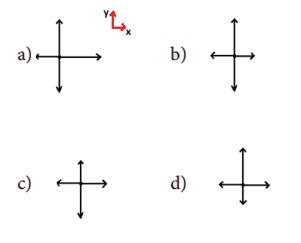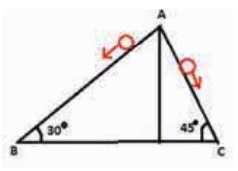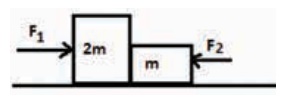Physics - Laws of Motion: Multiple choice questions with answers | 11th Physics : UNIT 3 : Laws of Motion
Chapter: 11th Physics : UNIT 3 : Laws of Motion
Laws of Motion: Multiple choice questions with answers
1.
When a car takes a sudden left turn in the curved road, passengers are pushed towards
the right due to
(a) inertia of direction
(b)
inertia of motion
(c)
inertia of rest
(d)
absence of inertia
2. An object of mass m held against a vertical wall by applying horizontal force F as shown in the figure. The minimum value of the force F is

(a)
Less than mg
(b)
Equal to mg
(c) Greater than mg
(d)
Cannot determine
3.
A vehicle is moving along the positive x direction, if sudden brake is applied,
then
(a) frictional force acting on the
vehicle is along negative x direction
(b)
frictional force acting on the vehicle is along positive x direction
(c)
no frictional force acts on the vehicle
(d)
frictional force acts in downward direction
4.
A book is at rest on the table which exerts a normal force on the book. If this
force is considered as reaction force, what is the action force according to
Newton’s third law?
(a)
Gravitational force exerted by Earth on the book
(b)
Gravitational force exerted by the book on Earth
(c) Normal force exerted by the
book on the table
(d)
None of the above
5.
Two masses m1 and m2 are experiencing the same force
where m1< m2. The ratio of their acceleration a1/a2
is
(a) 1
(b)
less than 1
(c) greater than 1
(d)
all the three cases
6.
Choose appropriate free body diagram for the particle experiencing net acceleration
along negative y direction. (Each arrow mark represents the force acting on the
system).

Ans: c
7.
A particle of mass m sliding on the smooth double inclined plane (shown in figure)
will experience

(a)
greater acceleration along the path AB
(b) greater acceleration along the path
AC
(c)
same acceleration in both the paths
(d)
no acceleration in both the paths.
8.
Two blocks of masses m and 2m are placed on a smooth horizontal surface as
shown. In the first case only a force F1 is applied from the left.
Later only a force F2 is applied from the right. If the force acting
at the interface of the two blocks in the two cases is same, then F1:F2:
is

(a)
1:1
(b)
1:2
(c) 2:1
(d)
1:3
9.
Force acting on the particle moving with constant speed is
(a)
always zero
(b) need not be zero
(c)
always non zero
(d)
cannot be concluded
10.
An object of mass m begins to move on the plane inclined at an angle θ. The
coefficient of static friction of inclined surface is μs. The
maximum static friction experienced by the mass is
(a)
mg
(b)
μs mg
(c)
μs mg sinθ
(d) μs mg cos θ
11.
When the object is moving at constant velocity on the rough surface,
(a) net force on the object is zero
(b)
no force acts on the object
(c)
only external force acts on the object
(d)
only kinetic friction acts on the object
12.
When an object is at rest on the inclined rough surface,
(a)
static and kinetic frictions acting on the object is zero
(b)
static friction is zero but kinetic friction is not zero
(c) static friction is not zero and
kinetic friction is zero
(d)
static and kinetic frictions are not zero
13.
The centrifugal force appears to exist
(a)
only in inertial frames
(b) only in rotating frames
(c)
in any accelerated frame
(d)
both in inertial and non-inertial frames
14.
Choose the correct statement from the following
(a)
Centrifugal and centripetal forces are action reaction pairs
(b)
Centripetal forces is a natural force
(c)
Centrifugal force arises from gravitational force
(d) Centripetal force acts towards
the center and centrifugal force appears to act away from the center in a
circular motion
15.
If a person moving from pole to equator, the centrifugal force acting on him
(a) increases
(b)
decreases
(c)
remains the same
(d)
increases and then decreases
Answers
1)
a 2) c 3) a 4) c 5) c
6)
c 7) b 8) c 9) b 10) d
11)
a 12) c 13) b 14) d 15) a
Related Topics